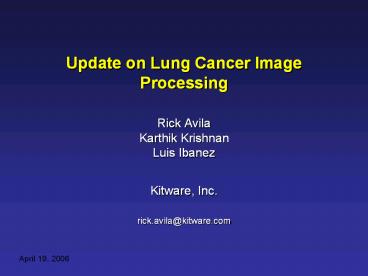Update on Lung Cancer Image Processing PowerPoint PPT Presentation
Title: Update on Lung Cancer Image Processing
1
Update on Lung Cancer Image Processing
- Rick Avila
- Karthik Krishnan
- Luis Ibanez
- Kitware, Inc.
- rick.avila_at_kitware.com
April 19, 2006
2
Therapy Assessment
- Assessment
- Tumor response
- ID new lesions
- Characteristics
- Late stage
- Thick CT
?
4 cm lesion
Tumor Size
Dt
?
Time
Start Therapy
Assess Response
3
RECIST
8mm DD, 13 pixels 73 DVolume
Progressive Disease
DD 20
Unaided Interpretation
4cm lesion
Target Lesion Measurement RECIST Sum of LD
Stable Disease
DD -30
Partial Response
Erasmus et. al., JCO 2003 Intra-observer
error PD 9.5 of tumors PR 3 of
tumors Inter-observer error PD 30 of
tumors PR 14 of tumors
weeks
Time
Complete Response
Baseline Treat
Assess Response
4
We can do better
- Improve
- Bias
- Variance
- For Lower
- Interval (Dt)
- Study N
4cm lesion
Target Lesion Measurement RECIST Sum of LD
Aided 3D Interpretation
Dt
Time
Early Detection Nodule Sizing
?
5
First Step Open Development Databases
All Cases Shown In This Presentation Came From
These Databases
6
Measurement Challenges
- Patient/Lesion Presentation
- Size
- Complexity
- Changes over time (necrosis)
- Scanners
- Hardware
- Software
- Protocols
- ScanRx
- Contrast
- Patient position
- Observer
- Seed points/ROI
- Data Interpretation
5mm
2.5mm
7
Complex Boundaries
8
Complex Boundaries
9
Volumetric Algorithm Challenges
- Boundary Identification Challenges
- Vascular network (Ev)
- Bronchial network (Eb)
- Pleura (Ep)
- Sub-voxel edge (Es)
- Errors at 2 time points
No/Small DI
Ev
Error strongly depends on lesion size and slice
thickness
10
Solid Algorithm Operating Envelope
Clinical Trials
5.0 mm
3.75 mm
Partial Volume
- Solution
- lt 1.25mm thickness
- Algorithm support for complex intersections
- Validate against wide patient and protocol
population
Slice Thickness
2.5 mm
Complex Boundaries
1.25 mm
Curvature
Noise
10mm
20mm
5mm
0
15mm
Lesion Size
11
Motivating Example
1D D 25
69d
46d
59mm
48mm
44mm
RECIST would classify response to therapy as
Stable Disease
12
3D Analysis
13
3D Analysis
14
Validation Approach
- Case Collection
- Collect cases w/many short interval scans
- Assessment on last scan(s) is clear
Progressive Disease
- Annotation
- One or more expert(s) classify each case based on
all data
Stable Disease
Response Metric
- Metric
- Measure sens/spec between assess pairs
- Compare metrics at last time point
- At what time can a sens/spec be met?
Partial Response
T1
T2
T3
T4
T5
Time
Complete Response
Baseline Treat
15
Open Database Collection Priorities
- Add Annotation to Open Databases
- Need to assess RECIST as the baseline performance
- Need an expert assessment of response for case
- Add More Cases to Open Databases
- Wide range of patient/lesion presentations
- Wide range of therapy interactions
- Emphasize Thin Slice
- Algorithms perform better (e.g. I)
- Collect Data at Smaller Time Intervals
- Algorithms perform better (e.g. registration)
16
- Thank You
17
Edge Detection
- Algorithms that utilize acquisition
characteristics - (e.g. PSF, SNR) can adapt to changes in
acquisition
Object
Scanner
Image
Step Function
PSF Noise
Recover Edge Using Acquisition Characteristics
Smooth
Localize
Elder et. al. TPAMI 1998
18
Cross-Platform Capability
- Goal
- Software achieves accuracy despite variation in
- Scanning equipment
- Acquisition protocols
- Solution
- Establish minimum acquisition standards/protocols
- Keep acquisition technique constant per patient
- Measure scanner characteristics utilizing a
standard phantom and publish - Utilize model-based algorithms
19
Unexpected Results
- Many studies report greater variance and error
when comparing 1D/2D/3D analysis - Issue 1 More is not always better
- All measurements need high precision
- Consider slice thickness
- Issue 2 New metrics need optimization
- Development data needed to establish best
separation between response classes

